Staff — February 10, 2015
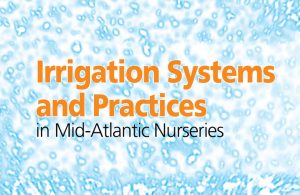
Nursery and greenhouse producers across the U.S. have become increasingly more aware of the importance of water use efficiency, prompted perhaps by water quality concerns in the East and Midwest and the current Western drought. More sophisticated irrigation equipment and procedures, careful timing of irrigation watering, and irrigation water recycling are some of the approaches taken to improve water use efficiency. Runoff capture and recycling entail both opportunities for greater irrigation water use efficiency as well as greater risk of disease pathogen buildup in recycled irrigation water.
Also of greater concern among nursery producers is the potential for expansion of regulations on irrigation water runoff. In 2010, the U.S. Environmental Protection Agency issued the Chesapeake Bay Total Maximum Daily Load for Nitrogen, Phosphorus and Sediment (TMDL) plan (http://www.epa.gov/reg3wapd/tmdl/ChesapeakeBay/index.html), which calls for progressive reductions in nutrient and sediment pollutant loadings from both point sources (such as water treatment plants) and nonpoint sources (such as nurseries), in order to achieve desired restoration conditions by 2025 in the Chesapeake Bay. Although nurseries and greenhouses are not subject to strict pollution controls such as those faced by water treatment plants, nursery growers in the Mid-Atlantic will likely be affected by state programs initiated to reduce nutrient and sediment runoff from nursery and greenhouse irrigation water runoff and storms.
In light of irrigation water and disease concerns, the U.S. Department of Agriculture (USDA) Specialty Crop Research Initiative funded a seven-university integrated research and extension project (USDA Irrigation Pathogens and Water Quality #2010-51181-21140) designed to improve water use efficiency and to protect the health of ornamental crops. Project objectives include the development of Best Management Practices (BMPs) for irrigation managers to increase water recycling and to mitigate water quality-related crop health risks.
Establishing the baselines
Development of BMPs and analysis of their costs and benefits is hindered by the lack of information about irrigation and disease management practices of Mid-Atlantic greenhouse and nursery growers. The Census of Horticultural Specialties is the most comprehensive source of data reflecting size and characteristics of the industry. The 2009 Census canvassed a broader spectrum of nursery businesses than utilized in this survey (including Christmas trees, food crops, seeds and transplants grown under protection, and sod). The Census surveyed businesses selling more than $10,000 of ornamental products in calendar year 2009, identifying 291 firms in Maryland, 999 firms in Pennsylvania and 297 firms in Virginia that represented the narrower spectrum of ornamental nurseries and greenhouses.
In 2013, operating nurseries with irrigation systems were surveyed in Maryland, Pennsylvania and Virginia. Input was obtained from academic and industry experts in development of the survey, which included site visits to growers in the 3 states, a focus group with growers and horticultural extension agents, and feedback from scientists and industry cooperators on the research project team.
Lacking a comprehensive list, nurseries were identified through an intensive World Wide Web search of business listings and then contacted to determine if they were still operating and would complete a mail survey. The survey form was designed to be completed in less than one-half hour and consisted of questions requesting information about the nursery’s general business characteristics, the nursery irrigation system, practices used to reduce the risk of disease infestation, and the respondent’s (usually the owner’s) attitude toward the risks of water shortage and disease outbreaks. Of 1,770 surveys distributed by mail, 434 valid returns were received (25 percent response), of which 259 responded that they irrigated ornamental plants in outside growing areas. This brief report summarizes survey results on nursery irrigation systems and practices, and a subsequent article will document responses concerning disease management practices.
Business Characteristics
Two hundred thirty-eight nursery respondents indicated their 2012 gross revenue. Of these, 152 were “small” businesses (less than $250,000 gross revenue), 51 were “medium” businesses ($250,000 to $1 million gross revenue) and 35 were “large” businesses with revenue greater than $1 million. The relatively small proportion of large businesses generates the majority of total sales. The 2009 Census (of all horticultural specialties) indicates that 40 Maryland nurseries, 50 Pennsylvania nurseries and 36 Virginia nurseries each had more than $1 million in 2009 sales, and that these large nurseries sell from 56 percent to 75 percent of total state nursery sales.
Among production nurseries, the responding firms conduct many types of business operations. The majority of large businesses are wholesale operations (74 percent wholesale and a further 9 percent combined wholesale-retail), while small and medium businesses are more evenly split between wholesale and retail. A small proportion of businesses in each size category are engaged in re-wholesale or other types of operations (See Figure 1).
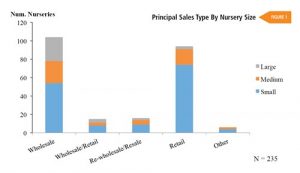
Figure 1.
Table 1 provides a breakdown of production systems by business size. Typically, nurseries report a combination of production systems, with containers and greenhouses being the most common. Large nurseries typically employ a combination of containers, field and /or hoop house production systems, with a strong focus on container production (69 percent of large businesses employ containers, either solely or in combination). In comparison, small businesses typically have greenhouses (18 percent of small nurseries used solely greenhouses and a further 34 percent used greenhouses in combination with other systems) and containers (52 percent of small nurseries used containers, usually in combination with other systems). Medium nurseries have a high proportion of combined production systems, with greenhouses, container nurseries and hoop houses being the most frequent combination.
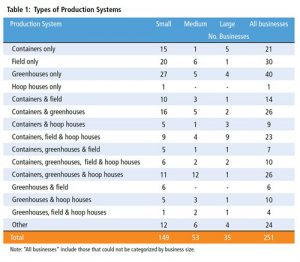
Table 1. Types of Production Systems
Nurseries typically exhibit considerable diversity in terms of plant types grown, with the majority of all producers earning less than 30 percent of sales from any particular plant type. Trees form the most reported plant category across small, medium and large nurseries, followed closely by evergreen shrubs and somewhat less commonly, deciduous shrubs. Few nurseries report sales of annual bedding or garden plants, herbaceous perennials or potted flowering plants (see Figure 2).
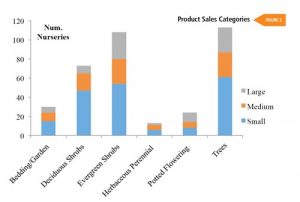
Figure 2.
Irrigation Water Source and Use
Nurseries reported their irrigation water sources and proportion of total irrigation water obtained from each. The small- and medium-sized nurseries differ little in this dimension, so they have been combined in Figure 3, while large nurseries are reported in Figure 4. Each chart shows the proportion of nursery irrigation water obtained by source. Fifty-eight percent of small and medium nurseries obtain irrigation water exclusively from wells, and 74 percent report sourcing at least some irrigation water from wells. Similarly, 77 percent of large businesses obtain some irrigation water from wells, but only 23 percent of large businesses rely exclusively on wells. Large businesses use a more diverse set of water sources, balancing reliance on wells with ponds.
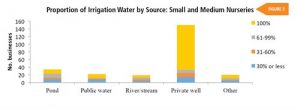
Figure 3.
Irrigation water usage was consistent across small and most medium nurseries. Nearly all small nurseries use less than 100,000 gallons on a typical summer’s day, and none of the medium nurseries uses more than 200,000 gallons per day. Among 31 larger nurseries reporting, more than one-quarter use greater than 500,000 gallons per day, and a few larger nurseries use greater than 1 million gallons per day (see Figure 5).
Due to differences in production systems (container, greenhouse, field), total production area irrigated is difficult to standardize across nurseries. In terms of total square feet irrigated, small nurseries irrigated an average of approximately 144,000 square feet, medium nurseries averaged 176,000 square feet, and large nurseries averaged 5.9 million square feet. Most nurseries reported using overhead sprinklers for at least a portion of their irrigation. Small and medium nurseries averaged about 100,000 square feet of production area irrigated with overhead sprinklers, while large nurseries averaged nearly 2.25 million square feet irrigated with overhead sprinklers. Nearly as prevalent across all nursery sizes was drip irrigation, with small nurseries averaging 167,000 square feet, medium nurseries averaging 530,000 square feet and large nurseries averaging 4.3 million square feet. Hand or hose watering was used to irrigate an average of approximately 10,000 square feet in small nurseries, 53,000 square feet in medium nurseries, and 76,000 square feet in large nurseries.
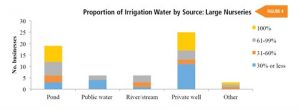
Figure 4.
Respondents were also asked to identify how many times in the past 10 years their nursery had run out or come close to running out of water (see Figure 6). Small nurseries appear to have more secure water sources, with 78 percent reporting that their irrigation water source had never been at risk in the past decade. In contrast, nearly 30 percent of medium and large nurseries had faced at least one year of water shortage in the past decade. Large nurseries were much more likely to have experienced irrigation water shortages, with 11 percent reporting that they had faced a shortage at least five times in the past 10 years. The greater water source risk faced by large nurseries is the likely reason for diversification of their water sources.
Runoff Capture
To recycle runoff water, it must first be captured and stored in ponds. Information on runoff capture from production areas was requested in the survey (see Figure 7). Overall, 35 percent of all nurseries indicated that they captured some irrigation and storm water runoff from their production area and drained it into ponds. Runoff capture into ponds was least common in small nurseries (22 percent), more in medium nurseries (44 percent) and predominant in large nurseries (83 percent).
Not only do most large nurseries capture some runoff into ponds, such nurseries also drain a higher proportion of 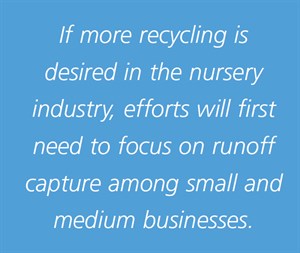 their production area into ponds. Among large nurseries, only 31 percent capture less than one-quarter of irrigation runoff, and nearly half of nurseries drain at least three-quarters of their production area into ponds. Among smaller nurseries that capture irrigation runoff, 11 percent of small nurseries and 21 percent of Continued from page 16 medium nurseries capture more than three-quarters of their irrigation runoff.
their production area into ponds. Among large nurseries, only 31 percent capture less than one-quarter of irrigation runoff, and nearly half of nurseries drain at least three-quarters of their production area into ponds. Among smaller nurseries that capture irrigation runoff, 11 percent of small nurseries and 21 percent of Continued from page 16 medium nurseries capture more than three-quarters of their irrigation runoff.
Recycling
Pond capacity is critical for those nurseries desiring to fully utilize runoff for irrigation, and from the environmental perspective, for retaining excess rainwater from storms on the facility rather than discharging to surrounding streams, wetlands or lakes.
If irrigation and/or storm water is captured, it becomes available to recycle for subsequent irrigation. The practice of recycling among respondents that capture is quite high, rising from 37 percent of small nurseries, to 67 percent of medium nurseries, to 76 percent of large businesses. Water captured into ponds makes up varying proportions of the total water used for nursery irrigation. About one-quarter of nurseries that capture recycle the water and get all their irrigation water from such ponds, but a nearly equal proportion of nurseries that capture only get 1 to 20 percent of their total irrigation water from recycled pond water.
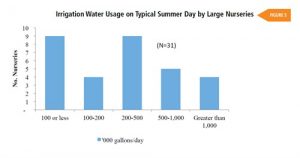
Figure 5.
Among the groups that capture water into ponds but do not recycle, two-thirds to three-fourths of respondents indicate that “high cost” or “land not suitable” are the major reasons for not recycling. Also indicated by such respondents was “increased disease risk” and “limited land.”
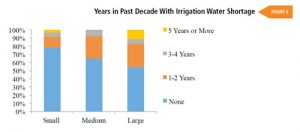
Figure 6.
If nurseries were required by state or federal regulations to capture all irrigation water and runoff from storms, most would find compliance to be difficult and costly. Figure 8 shows modifications indicated as necessary for compliance by business size. Overall, the most common necessary actions would be “construct new ponds in production area” and “modify greenhouse/ production area to facilitate drainage,” followed by “change irrigation practices.” Although this question probed necessary steps for full runoff capture, responses do not necessarily indicate whether nurseries were financially capable of full compliance. In fact, 19 nursery respondents indicated that they would close the business if required to recycle. Clearly, adoption of runoff capture and recycling is viewed as infeasible by many nurseries not currently utilizing this irrigation strategy.
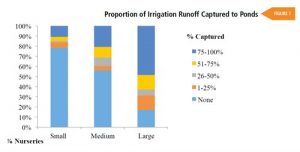
Figure 7.
Let’s recap
Development and cost analysis of ornamental nursery and greenhouse BMPs would be facilitated by collecting and compiling information about irrigation and disease management practices. This survey collected information from 259 nurseries and greenhouses in Maryland, Pennsylvania, and Virginia about their practices. Responding nurseries display a wide range of production facilities with only a few specializing in containers, field, greenhouse, or nursery production only. Most nurseries concentrate on certain plant categories, but diversify within categories. Approximately three-quarters of large nurseries report production of trees and evergreen shrubs, while 20 to 40 percent of small and medium nurseries produce deciduous shrubs, evergreen shrubs, and trees. Bedding plants, herbaceous perennials, and potted flowering plants are produced by a relatively small number of nurseries across business sizes.
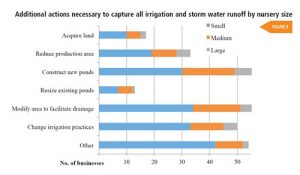
Figure 8.
Well water is the principal source of irrigation water for nurseries across size categories, with heavy reliance by small and medium nurseries. Seventy-four percent of small and medium nurseries report using well water as a source of some irrigation water, and 62 percent of small nurseries rely exclusively on wells. Similarly, 71 percent of large nurseries report using some well water for irrigation, but only 23 percent of large nurseries rely on well water exclusively. With respect to water sourcing from ponds, 54 percent of large businesses obtained irrigation water from ponds, but only 17 percent of all smaller businesses used ponds. Diversification of water source in large nurseries is accomplished by the use of ponds fed by irrigation and rainwater runoff.
Considering irrigation water shortages, only a small number of small nurseries and no medium nurseries report having experienced a water shortage over the past decade. On the other hand, nearly one-half of large nurseries have experienced at least one year of water shortage over the past decade. Water shortage is presumably related to a lack of rainfall on large nurseries; reliance on ponds is most perilous when rainfall is short.

Runoff capture is very common in large nurseries (83 percent), but much less common on small and medium nurseries (22 percent and 39 percent, respectively). Nearly one-half of large nurseries drain at least 75 percent of their production area to ponds, with a much smaller proportion of small and medium nurseries draining that much of their production area (11 percent and 21 percent, respectively). Among nurseries that capture runoff water, only 9 percent have the collection pond capacity to store all typical irrigation and rain water runoff, and much smaller proportions can store irrigation runoff plus runoff from a 2-inch to 3-inch storm, even on large nurseries. If nurseries were required by state or federal regulations to capture all irrigation water and runoff from storms, most would find compliance difficult, if not infeasible. Respondents indicated that actions necessary to achieve compliance with such regulations would involve substantial capital investment, and unsolicited responses by 19 nurseries indicated that they would close their business if faced with such regulations.
It is apparent that larger nurseries are more likely both to capture and to recycle than small and medium businesses. If more recycling is desired in the nursery industry, efforts will first need to focus on runoff capture among small and medium businesses. Increased recycling also brings the prospect of greater expense and monitoring to reduce the likelihood of disease pathogen buildup in irrigation pond water.
Nursery characteristics and opinions with respect to disease management will be reported in a subsequent article.